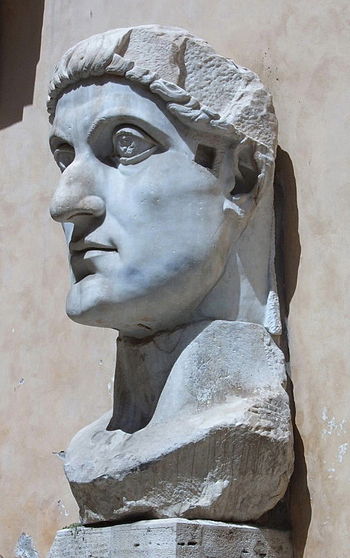 |
| English: Side view of Ponte Milvio, Rome. (Photo credit: Wikipedia) |
 |
| Head of the colossal statue of Constantine I, Musei Capitolini, Rome. Marble, Roman artwork, 313–324 CE. (Photo credit: Wikipedia) |
 |
| Constantine at the battle of the Milvian Bridge, fresco by Raphael, Vatican Rooms. (Photo credit: Wikipedia) |
When did the Church of Christ Constantine
faced his rival Maxentius on the Milvian
Bridge that spanned the Tiber River
into Rome
It was on this bridge that Constantine
prayed for victory over the enemy of Rome Constantine Constantine
out fitted his men with this sign of the Lord's protection, and on the next day
Constantine Constantine
This time of peace allowed formerly persecuted church
leaders and theologians some time to focus on the praise and nature of Christ.
The sacraments and liturgical practices that had been the focus of Christian
worship were now defined in a way that brought a wonderful reassuring
uniformity that brought comfort to the faithful in the churches throughout the
Empire. It also gave the missionaries of the church an opportunity to present a
more coherent faith to the rest of the pagan world.
With in one generation of the ushering in of this
unprecedented cohesion in the development of sacramental and theological
teachings of the church, it could now be said the church was truly
'"Catholic." Bishop of Jerusalem Cyril wrote a treatise on what
differed the Catholic Church from those fragmented Christian sects that still
continued to exist. He that when inqiriuing some place away from one's home
Chruch one should not just as where the Lord's House was, but rather where the
Catholic Church met." For this is the peculiar name of this Holy Church
He went on say the Catholic church , because it extends
over all the worldfrom one end of the earth to the other; universally and
completely one and all doctrines which ought to come to human knowledge
,concerning things both visible and invisible, heavenly and earthly,
So even those of the faithful who do not practice this day
in the Roman Catholic Church we are being nevertheless Catholic when were pray
the liturgical prays of the Daily Office and in worship participate in the
sacraments brought to perfection by the ancient Catholic church. We are
transformed in fellowship with the risen Christ and moved to reconcile
ourselves to God and to do the work among the least of us, in the name of the
Lord. St. Ignatious of Antioch Constantine 's Milvian Bridge
Sources 



No comments:
Post a Comment